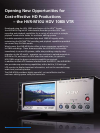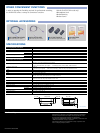
HDV 1080i Specification
1
The HDV 1080i specification of the HDV format features 1080 effective
scanning lines (interlace scanning system) and 1,440 horizontal pixels.
It adopts the MPEG-2 compression format (MP@H-14 for video), which uses
8-bit digital component recording with a sampling rate of 4:2:0. MPEG-1
Audio Layer II is used as the audio
compression format, allowing for
two-channel recording with a
sampling frequency of 48 kHz/16-bit.
The HDV 1080i specification provides
high picture quality that can be used
for HDTV program production.
1 The HDV format also defines the HDV 720p
specification, which features 720 effective
scanning lines (progressive scanning system)
and 1,280 horizontal pixels.
Compatible with Existing and New DV Videocassette Tape
As a member of the proven DV family of formats, the HDV format has, from
the outset, been developed for compatibility with all grades of DV videocassette
tape. This allows operators to use high-grade DV videocassette tapes for
applications where high robustness is critical, or consumer-grade videocassette
tapes for more economical operations. For heavy-duty applications, newly
developed high-grade PHDVM-63DM Mini Cassette tape, DigitalMaster
TM
,
which is compatible with the HDV, DVCAM and DV formats, is available.
Long Recording Time
The HDV format adopts the same track pitch and tape speed as the DV format,
thus offering the same recording time – a maximum of 63 minutes on a mini
videocassette such as DigitalMaster tape.
Direction of tape travel
10 µm
Sub Code sector
MPEG-2 PES sector
(Video + Audio + Search + AUX)
ITI sector
Direction
of head motion
6.35 mm
(1/4 inch)
ITI: Insert and Track Information
PES: Packetized Elementary Stream
A New Addition to the HD Format that Broadens
the Scope of HD Program Production
HDV FORMAT
FRONT VIEW
3
Track Pattern of the HDV 1080i Specification








